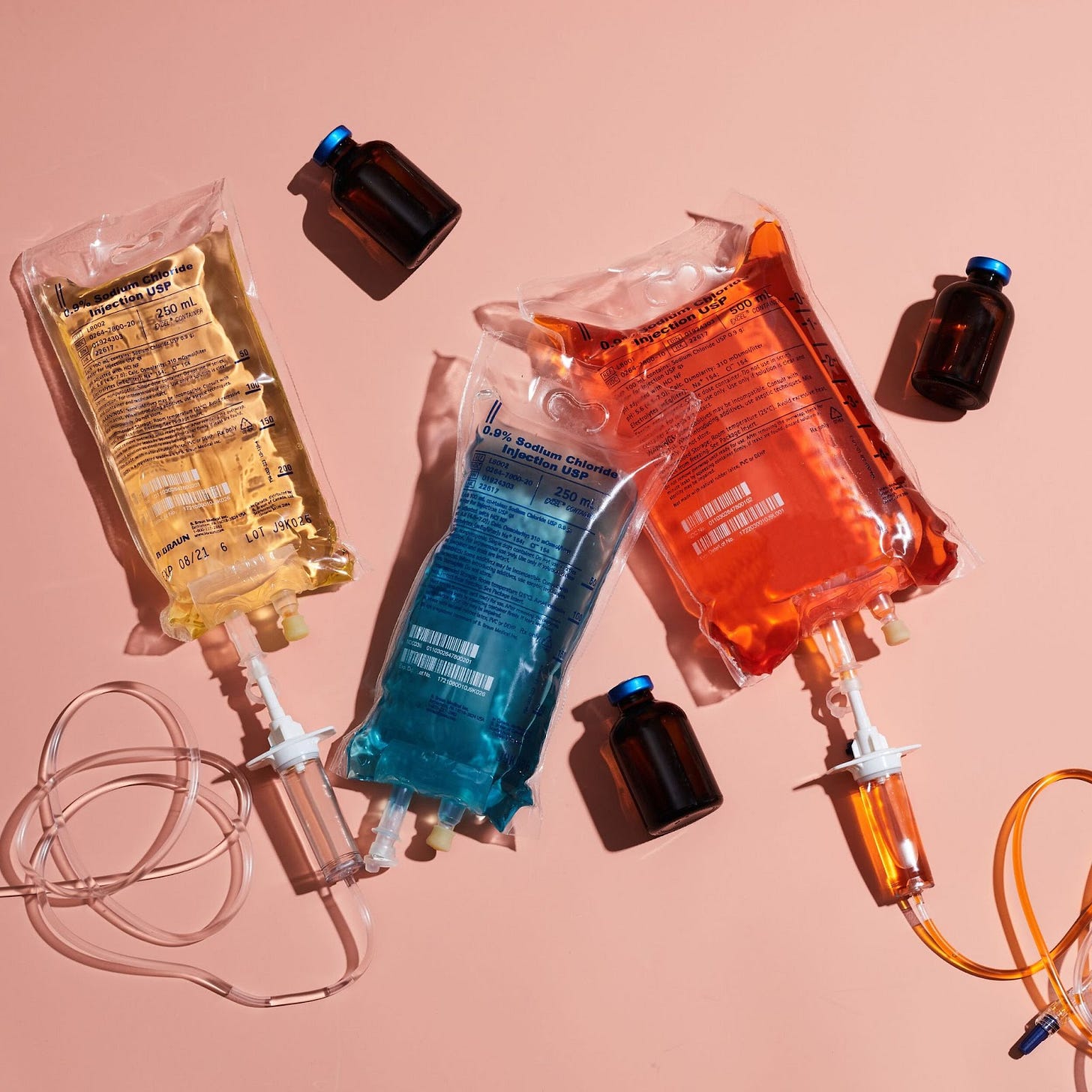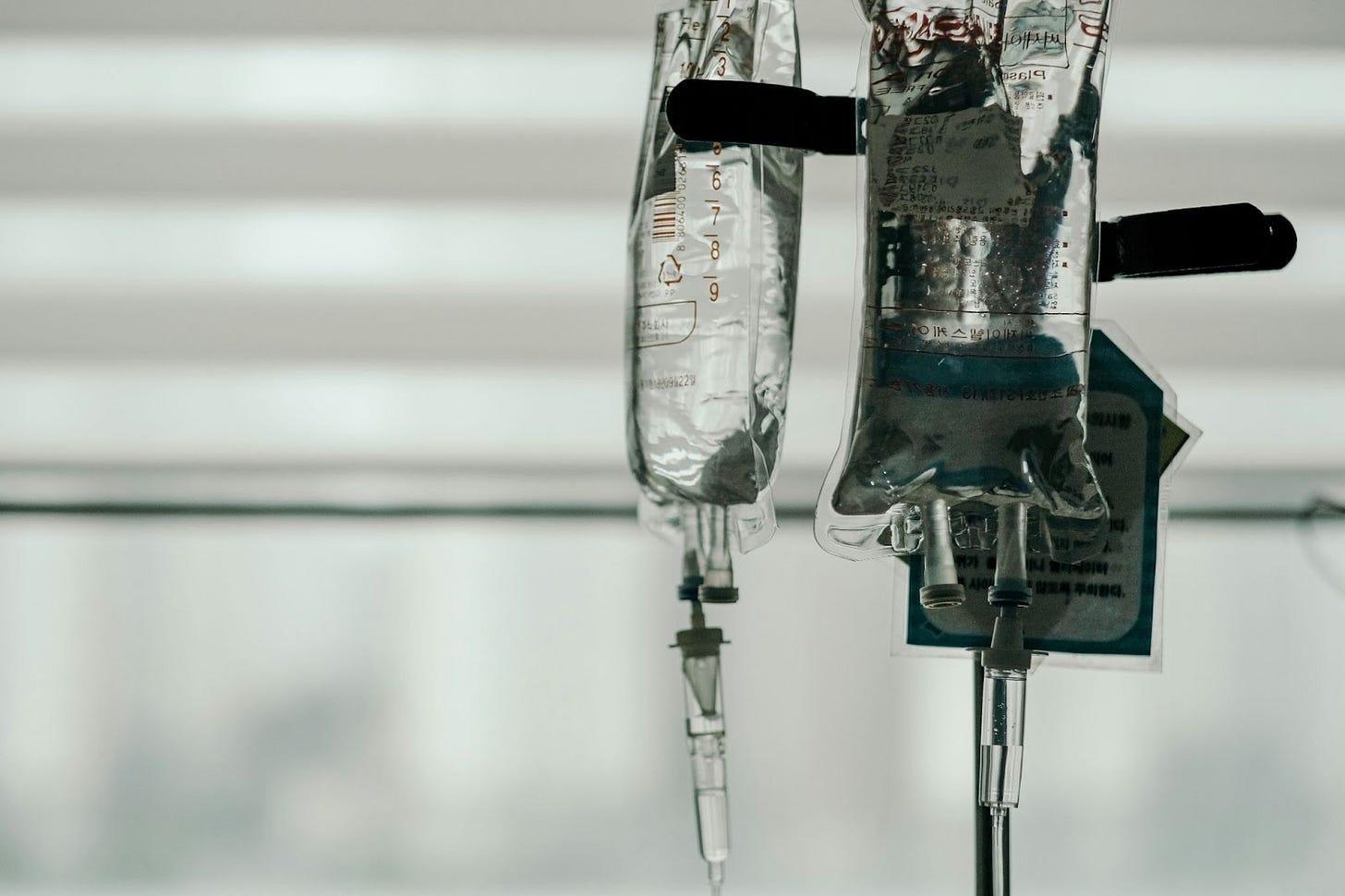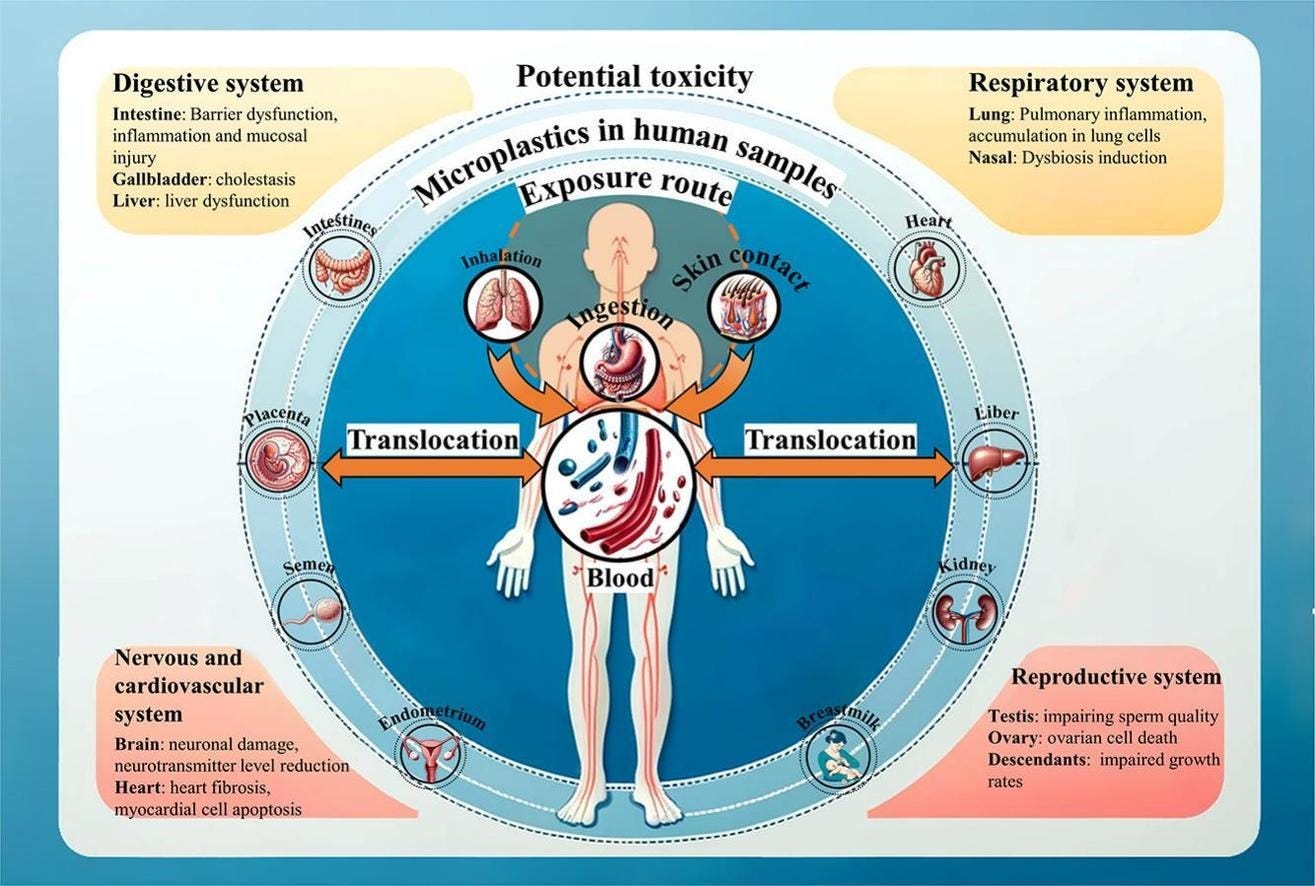IV Wellness Therapy: The Hidden Cost of Chasing Shortcuts
Exposing the disconnect between marketing promises and biological reality
We're living in an age where people willingly pay hundreds of dollars to inject vitamins directly into their bloodstream—vitamins they could get from a $5 bottle at the pharmacy or some healthy vegetables made from sun, water and soil. But this is what should worry you: These expensive nutrient injections also contain a cocktail of microplastics and chemical additives that your body wasn't designed to process.
This isn't hyperbole. This is science, and it's urgent.
The Seductive Promise of Wellness Shortcuts
I understand the appeal. We're exhausted, overwhelmed, and constantly searching for that edge—that one thing that might make us feel truly optimized. The wellness industry knows this, and they've crafted a narrative as compelling as it is misleading.
Picture this: you walk into a sleek clinic, settle into a leather chair, and within minutes, you're receiving what feels like a medical-grade performance enhancement. Celebrities endorse it. Influencers document it. The marketing promises are intoxicating—instant energy, enhanced immunity, detoxification on demand.
It’s important to understand something critical: this entire premise rests on a fundamental misunderstanding of how your body works. More importantly, it's exposing you to risks that no one is talking about.
The Plastic Reality Hidden in Plain Sight
Here's what the wellness clinics won't tell you, because frankly, most of them don't know: every IV bag and its tubing is essentially a plastic container, releasing microscopic particles directly into your bloodstream.
This isn't theoretical. A 2025 peer-reviewed study documented that commonly used IV infusion products released up to 58,200 microplastic particles per liter of IV fluid. The particles consisted of polyvinyl chloride (PVC), polypropylene (PP), and polyethylene (PE), and ranged in size from 10 nanometers to 3.6 micrometers. A previous 2023 study by the same group found bags made of PVC released up to 0.52 micrograms of microplastics per 250 ml of IV infusion.
Think about that for a moment. The bags and tubing themselves shed these particles. They're too small for standard medical filters to catch, which means they're now circulating in your blood, potentially lodging in your organs, and accumulating in ways we're only beginning to understand.
But it gets worse. Many IV bags still contain polyvinyl chloride (PVC), which leaches DEHP—a known endocrine disruptor and probable carcinogen.
DEHP and PVC: Long-Standing Chemical Concerns
Diethylhexyl phthalate (DEHP) is a plasticizer commonly used to soften polyvinyl chloride (PVC) in medical devices. However, DEHP leaches into IV fluids, especially when exposed to heat or pressure, posing potential health risks . The U.S. Agency for Toxic Substances and Disease Registry has classified DEHP as “reasonably anticipated to be a human carcinogen.”
PVC medical devices, such as IV bags and blood bags, typically contain 30-40% DEHP by weight; other devices such as medical tubing may contain as much as 80% DEHP by weight.
Several studies have found that DEHP leached from PVC blood bags, IV bags and tubing into blood, blood platelet and red cell concentrates in amounts ranging from 4 to 650mg/liter.
Researchers measured DEHP concentrations ranging from 3.1 to 237 mg/liter in solutions containing drugs and solvents, and 5mg/liter in sterile water and salt and sugar-based solutions.
The Route Matters More Than the Dose
I want you to grasp something crucial about exposure pathways. When you accidentally ingest microplastics from food or water, or inhale them via the air you breathe, your body has multiple defense mechanisms—stomach acid, liver processing, kidney filtration, mucociliary lung clearance and ultimately excretion. But when you inject these particles directly into your bloodstream, you're bypassing every single one of these protective systems.
This isn't like swallowing a microscopic piece of plastic and hoping it passes through. This is direct vascular exposure, with particles that can cross the blood-brain barrier, trigger cellular inflammation, and potentially contribute to cardiovascular and multisystem disease. The research on this is emerging rapidly, and none of it is reassuring.
Scientists found microplastics in the blood of healthy humans (1.6 micrograms/milliliter).
I had the opportunity to test levels of microplastics in my blood with my good friend Dr. Kari Nadeau, the chair at Harvard's Department of Environmental Health. (She is speaking at DOC this year!) Of the forty plastic polymers tested for, my levels were found to be extremely low. By way of comparison, a test result with higher levels is shown below.
Scientists have also found microplastics in human thrombi (blood clots from patients undergoing cardiovascular surgery) comprising polyethylene microplastic and pigment additive particles.
Source: Di Wu, Yudong Feng, Rui Wang, Jin Jiang, Quanquan Guan, Xu Yang, Hongcheng Wei, Yankai Xia, Yongming Luo. Pigment microparticles and microplastics found in human thrombi based on Raman spectral evidence. Journal of Advanced Research, Volume 49, 2023,Pages 141-150
In another study, among patients with asymptomatic high-grade carotid artery stenosis undergoing carotid endarterectomy surgery, 58% had evidence of microplastics in their atheroma; those with microplastics within carotid plaque were 4.5 times more likely to experience a composite of myocardial infarction (heart attack), stroke or death from any cause within three years of surgery.
In fact, microplastics exposure (from food, drink, air, dermal contact and IV therapy) may have potential health implications for nearly every organ system in the body, from endocrine disruption to allergies and asthma to heart disease.
Source: Yue Li, Liping Chen, Nonglin Zhou, Yuyuan Chen, Zhichen Ling, Ping Xiang. Microplastics in the human body: A comprehensive review of exposure, distribution, migration mechanisms, and toxicity. Science of The Total Environment, Volume 946, 2024
The Evidence Gap That Should Terrify You
Here's the uncomfortable truth that undermines this entire industry: there is virtually no credible scientific evidence that IV therapy benefits healthy people with functioning digestive systems. None.
Your gastrointestinal tract is a marvel of evolutionary engineering. It's designed to extract, process, and deliver nutrients with remarkable efficiency. When you bypass this system unnecessarily, you're not optimizing—you're outsmarting millions of years of biological refinement, and you're paying for the privilege.
Dehydrated? Drink water. Tired? Address your sleep, stress, or underlying health issues. Vitamin deficient? Take oral supplements that cost a fraction of the price and don't require puncturing your skin.
The Regulatory Vacuum We're Operating In
The most alarming aspect of this trend is how it exploits regulatory blind spots. The Food and Drug Administration (FDA) doesn't currently regulate microplastic content in medical devices because we're only now developing the technology to properly measure and understand these exposures.
Nanoplastics—particles smaller than 0.1 micrometer—are particularly insidious because they're nearly impossible to detect with current methods. The tools we use to identify them often destroy the very particles we're trying to study. This creates a perfect storm: an unregulated industry selling unproven treatments with unmeasured risks.
The Mathematics of Unnecessary Risk
Let me put this in perspective. It may seem that a typical IV bag releases negligible amounts of microplastics per use by weight, but that's missing the point entirely. When we're talking about particles that can trigger oxidative stress, cross biological barriers, and accumulate in tissue, mass becomes less important than distribution and bioactivity.
Wellness clinics typically downplay the other hazards of IV therapy, presenting it as a benign spa service akin to a facial treatment. However, inserting a needle into a vein always carries risks. Infection stands as one of the most serious concerns - bypassing the skin's protective barrier can introduce bacteria directly into the bloodstream, potentially leading to localized or systemic infections, including sepsis.
Vein inflammation (phlebitis) and clotting (thrombophlebitis) represent additional complications, especially with acidic or improperly balanced solutions. Though uncommon, these issues can occur even with routine IVs administered by experienced professionals. More concerning still are allergic reactions to IV components, which can range from mild rashes to life-threatening anaphylaxis.
Consider this: in hospital settings, where IV therapy can literally save lives, this risk-benefit calculation makes sense. When you're using the same technology to deliver expensive vitamins to healthy people seeking a wellness boost, this proposition becomes hard to justify.
A Movement Built on Contradiction
There's a profound irony here that we need to address. The clean living movement—the same community that scrutinizes food labels, avoids processed ingredients, and seeks "natural" solutions—is enthusiastically embracing a treatment that injects plastic particles and industrial chemicals directly into their bloodstream.
This can’t be reconciled with sound logic. We have been primed to confuse medical intervention with wellness optimization.
The Path Forward Requires Courage
We demand better evidence and transparency from an industry that's profiting from your desire to feel optimal. As Carl Sagan said, ‘extraordinary claims demand extraordinary evidence’ - and we have little to zero evidence for IV therapy as a strategy for well-being.
Before you book that next wellness IV, ask these questions:
What specific clinical studies support this treatment for someone with my health profile?
What are the microplastic and chemical additive levels in the products being used? When they say there is none, ask them to show you the trusted third party evaluation.
How does this compare to oral supplementation in terms of both efficacy and safety?
The silence you'll likely encounter should tell you everything you need to know.
Industry Response: Transition to Safer Materials
Several manufacturers have taken proactive steps to eliminate DEHP and PVC from their products:
B. Braun: Offers a full line of IV solution and irrigation containers made from polypropylene, a less toxic and more recyclable material. Their products are free from DEHP and PVC, aiming to reduce patient exposure to harmful chemicals .
Fresenius Kabi: Produces the freeflex® line of IV bags, which are 100% PVC and DEHP-free. These bags are designed with polyolefin materials, enhancing patient safety and environmental sustainability .
ICU Medical: Provides a broad portfolio of non-PVC and non-DEHP IV solution containers, catering to various clinical needs while prioritizing patient safety .
Legislative Action: California’s Toxic-Free Medical Devices Act
California has enacted the Toxic-Free Medical Devices Act (AB 2300), which prohibits the use of DEHP in IV bags and tubing manufactured, sold, or used in the state. The ban on DEHP in IV solution containers takes effect on January 1, 2030, and extends to IV tubing on January 1, 2035 . This legislation underscores the state’s commitment to reducing patient exposure to toxic chemicals in medical settings.
Innovations: Exploring Alternative Materials
The medical device industry is actively researching and developing alternatives to traditional plastics to minimize leaching:
Alternative Polymers: Transitioning from PVC to materials like polypropylene (PP) and polyethylene (PE) is a common strategy to reduce chemical leaching.
Bio-based and Biodegradable Materials: Companies like Lactips are developing bio-based, biodegradable polymers, such as CareTips®, derived from natural proteins. These materials are designed to be microplastic-free and degrade in various environments, offering a promising alternative for medical applications .
Surface Treatments and Coatings: Applying plasma treatments or advanced coatings to plastic surfaces can alter their properties, potentially reducing leaching and improving biocompatibility.
Navigating Towards Safer IV Therapies
While the complete elimination of microplastic exposure from IV therapy remains a challenge, significant strides are being made:
Product Selection: Opting for IV bags and tubing from manufacturers committed to DEHP and PVC-free products can reduce known chemical leaching risks.
Regulatory Compliance: Adhering to upcoming regulations, such as California’s Toxic-Free Medical Devices Act, will further drive the adoption of safer materials in medical devices.
Continued Research: Ongoing studies and innovations are crucial to developing materials and technologies that minimize or eliminate microplastic shedding in medical applications.
Your Body Knows What It's Doing
Your digestive system isn't a design flaw that needs to be bypassed—it's a sophisticated processing center that's served our species remarkably well. When we shortcut this system without compelling medical necessity, we're not bio-hacking; we're introducing unnecessary risk.
The wellness industry has convinced us that more intervention equals better health. But real optimization isn’t found in a bag hanging from an IV pole. It’s found in the courage to step back from the shortcuts and invest in the fundamentals that actually work. The most radical thing you can do is trust that your body, when properly supported with basic nutrients, adequate sleep, regular movement, and stress management, is extraordinarily capable of maintaining itself.
At the end of the day, each of us is a sovereign—ruler of our own body, steward of our own choices, monarch of our molecular kingdom. If someone wants to chase vitality through a plastic bag and a drip of promise, that is their sovereign right. We each get to choose our elixirs, our shortcuts, our gambles. Life, after all, is a casino that only accepts bets in the currency of our one precious existence—and sometimes, you just hope the house doesn’t always win.
But I’d simply urge more people to question the odds - read the fine print, look under the hood and think critically before buying into the beautifully marketed shortcut. Curiosity is free. So is skepticism. And both are far more potent than most of what’s in that IV.














